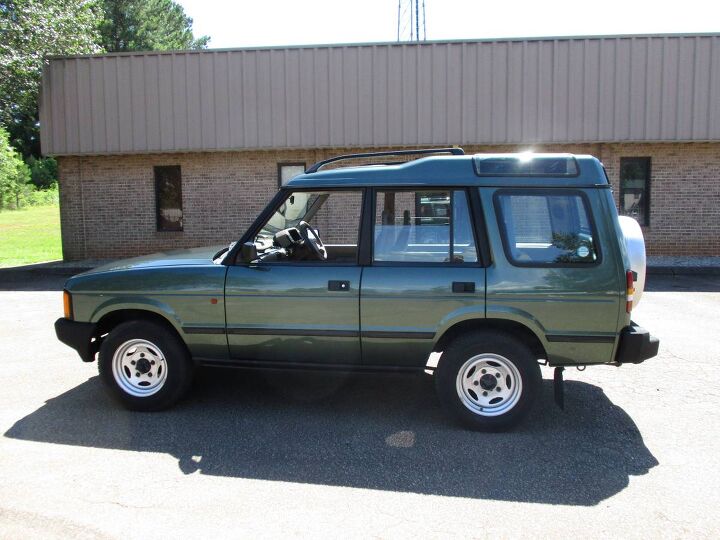Rare Rides: Discovering the Honda Crossroad of 1993

Throughout the 1980s, and into the middle of the nineties, Honda reassured themselves that the sports utility vehicle craze was just a fad. The company spent years refusing to develop their own SUVs of any caliber, and instead turned to other companies (eventually) to fill gaps in the model lineup.
Honda did rebadging work to various extents, and then sold the borrowed SUVs around the world. Today’s Rare Ride is one such offering, though it’s more obscure then all of its stablemates down at Honda Rebadge Corral. Let’s check out a Honda Crossroad, from 1993.
Honda first entered the hot SUV market in 1993 with two offerings, supplemented by an additional sibling in 1994. For ’93 the company’s global SUV was a lightly reworked Isuzu Rodeo, sold as the Passport. For the Japanese domestic market and a few special customers in New Zealand, the Land Rover Discovery started a new life as the Crossroad. In 1994, Honda started borrowing the Isuzu Trooper for markets outside North America, and selected a prestigious American-type name: Horizon. North American customers received a Honda-tized Trooper with the Acura SLX, but sales didn’t start until 1996.
Model lesson over, back to Crossroad.
The Crossroad had a difficult birth. Though market research showed the SUV market was so hot at the time, Honda couldn’t easily rebadge a Land Rover and sell it to North America as a less prestigious marque. But the Discovery was ripe for the picking: Honda’s overseas operations and Rover were very familiar with one another via a long-standing cooperative agreement. Rover needed Honda’s engineering assistance in making reliable cars. North American customers reaped the benefits of the partnership via ruined Acura Legends called the Sterling 827. “Japan will buy the Discovery,” they thought.
On sale in October of 1993 as a ’94 model, Honda slipped the Crossroad into its vast domestic dealership network. Changes were minimal, and included some badges, and different wheel designs in some cases. All Crossroads had the 3.9-liter Rover V8 (though they wore the Discovery’s TDI grille), and were the first and only commercial Honda passenger cars with eight cylinders. Japanese road tax on 3.9 liters displacement was substantial. But even discounting the taxation issue, all was not well.
The H badge on the front didn’t stop the Crossroad from having British levels of reliability. Imagine the pleasure Japanese Honda mechanics felt when a Crossroad pulled into the service bay next to an Aerodeck. Early on in the Crossroad’s life, Honda received troubling news: Rover lost its independence via a sale to BMW.
Honda wasn’t pleased, and BMW’s chairman made a quick flight over to Japan to try and keep the deal afloat. Whatever he said worked, and the partnership stayed intact. The Crossroad remained on sale at Japanese Honda dealerships through 1998, which coincided with the conclusion of the Discovery I’s production. By then the much more palatable and conventional CR-V was available, and Honda’s SUV offering woes began to subside.
Today’s Rare Ride is located in Greenville, which is in South Carolina. Other photos show the owner is one of the growing number of JDM vehicle importers. In clean condition, the asking price is $9,995.
[Images: seller]

Interested in lots of cars and their various historical contexts. Started writing articles for TTAC in late 2016, when my first posts were QOTDs. From there I started a few new series like Rare Rides, Buy/Drive/Burn, Abandoned History, and most recently Rare Rides Icons. Operating from a home base in Cincinnati, Ohio, a relative auto journalist dead zone. Many of my articles are prompted by something I'll see on social media that sparks my interest and causes me to research. Finding articles and information from the early days of the internet and beyond that covers the little details lost to time: trim packages, color and wheel choices, interior fabrics. Beyond those, I'm fascinated by automotive industry experiments, both failures and successes. Lately I've taken an interest in AI, and generating "what if" type images for car models long dead. Reincarnating a modern Toyota Paseo, Lincoln Mark IX, or Isuzu Trooper through a text prompt is fun. Fun to post them on Twitter too, and watch people overreact. To that end, the social media I use most is Twitter, @CoreyLewis86. I also contribute pieces for Forbes Wheels and Forbes Home.
More by Corey Lewis
Latest Car Reviews
Read moreLatest Product Reviews
Read moreRecent Comments
- ToolGuy If these guys opened a hotel outside Cincinnati I would go there to sleep, and to dream.
- ToolGuy Michelin's price increases mean that my relationship with them as a customer is not sustainable. 🙁
- Kwik_Shift_Pro4X I wonder if Fiat would pull off old world Italian charm full of well intentioned stereotypes.
- Chelsea I actually used to work for this guy
- SaulTigh Saw my first Cybertruck last weekend. Looked like a kit car...not an even panel to be seen.











































Comments
Join the conversation
This ride is awesome.
The Rover V8 was of course the Buick V8 which in fairness to Rover they improved and improved of decades. In fact Rover did such a good job with the engine that GM tried to buy the right back to it again. GM had managed to create a lightweight V8 at a time when there wasn’t much call for one, only later did they realise it’s true value, it’s a fascinating story in its own right. As for Land Rovers I love personally think that the problem with the current crop is that they are far too complex. They are the most complex cars you can buy. Think about the door handles on a Velar alone. They need to step back and simplify their designs, it’s not an assembly problem. Same goes for Jaguar, why put rotating air vents in a car? Having said all of the above I would buy one, why? Because it is complex and they are different. Vive la difference I say!